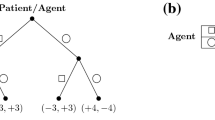Abstract
The number of young children classified as being affected with attention deficit/hyperactivity disorder (ADHD) is reaching a very serious level. A method to help children with attention-related conditions such as ADHD without depending on drugs is required. In this context, the necessity for research on means of improving attention through the use of computer games, loved by children, has recently been highlighted. Therefore, in this study, research on variables that enable the measurement of attention leading to the development of tangible games to improve attention while children are playing these types of games by moving their bodies is done. First, measurement variables are selected based on a survey of existing attention measurement methods in a computer environment. Experimental research is then conducted to find if children with attention deficits and normal children can be distinguished in terms of the selected measurement variables in the tangible game environment. Those variables are omission error, commission error, average response time, and standard deviation of response time. According to the results, four variables are confirmed to be usable to measure and assess attention in the tangible game to be developed through this study. With these experimental results, a 3D tangible game that improves children’s attention level can be developed.






Similar content being viewed by others
References
Roh, B. H. (2011). A study on the social welfare system to support the emotional development of ADHD children. The Journal of the Korean Association for Local Government and Administration Studies, 25(2), 255–278.
Research report on Pilot Operation Project of Mental Health Examination of Students. Republic of Korea: Ministry of Education, Science and Technology.
Choi, J. A., & Cho, A. N. (2010). A effects of social skill program on improving sociality and self-concept of children with ADHD symptoms. Korean Association of Parent Counselling and Play Therapy, 1, 89–105.
DuPaul, G. D., & Stoner, G. (2003). ADHD in the schools: Assessment and intervention strategies. New York: Guilford Press.
Kim, M. Y., & Hong, Y. G. (2009). A single case study on a child with ADHD by the application of attention improvement training composed of play and games. The Korean Journal of Elementary Counseling, 8(1), 15–32.
Cheong, K. M. (1991). Effects of task type and feedback on vigilance task performance of ADHD children. M.S. Thesis, Yonsei University of Repulic of Korea.
Kim, E. Y. (1995). Stratified test of attention based on perceptual-task difficulty for ADHD children. M.S. Thesis, Yonsei University of Repulic of Korea.
Lee, Y. M. (2003). Effect of integrative play therapy on ADHD children. Ph.D. thesis, Sookmyung Women’s University of Repulic of Korea.
Choi, J. A. (2012). Literature review of play therapy intervention for children with ADHD. Journal of the Korean Home Economics Association, 50(5), 125–138.
Nam, M. S., & Lee, Y. J. (2004). The effect of concentration-playing program on the inattentive behavior, in the student with ADHD. The Journal of the Korean Association on Developmental Disabilities, 8(1), 73–86.
Cho, S. J., & Yoon, H. S. (2011). A study on the improvement of concentration through serious games. The Journal of the Korea Game Society, 11(4), 27–35.
Brain Oasis. http://www.brainoasis.co.kr.
Pontifex, M. B., et al. (2013). Exercise improves behavioral, neurocognitive, and scholastic performance in children with ADHD. Journal of Pediatrics, 162(3), 543–551.
Eun, S. H., & Eun, B. L. (2008). Attention deficit hyperactivity disorder-review article. Korean Journal of Pediatrics, 51(9), 935–943.
Shin, M. S., Cho, S. Z., et al. (2000). A study of the development and standardization of ADHD diagnostic system. Korean Journal of Child and Adolescent Psychiatry, 11(1), 91–99.
Robert, A. L., Greenberg, L., et al. (2007). T.O.V.A. Professional Manual. Loa Alamitos.
About the T.O.V.A. http://www.tovatest.com.
Prasad, R., Pruthi, P., & Ramareddy, K. (2009). The top 10 list for terabit speed wireless personal services. Wireless Personal Communications, 49, 299–309.
Antoniac, P., et al. (2002). Wireless user perspectives in europe: Handsmart mediaphone interface. Wireless Personal Communications, 22, 161–174.
Newman, K. E., & Blei, M. (2003). Evaluation of smart phones for remote control of a standard hospital room. Wireless Personal Communications. doi:10.1007/s11277-013-1404-5.
Yoon, K. S. (2012). Research on interactive multimedia productions with Kinect. M.S. Thesis, DongGuk University of Republic of Korea.
Author information
Authors and Affiliations
Corresponding author
Rights and permissions
About this article
Cite this article
Roh, C.H., Lee, W.B. A Study of the Attention Measurement Variables of a Serious Game as a Treatment for ADHD. Wireless Pers Commun 79, 2485–2498 (2014). https://doi.org/10.1007/s11277-014-1744-9
Published:
Issue Date:
DOI: https://doi.org/10.1007/s11277-014-1744-9




